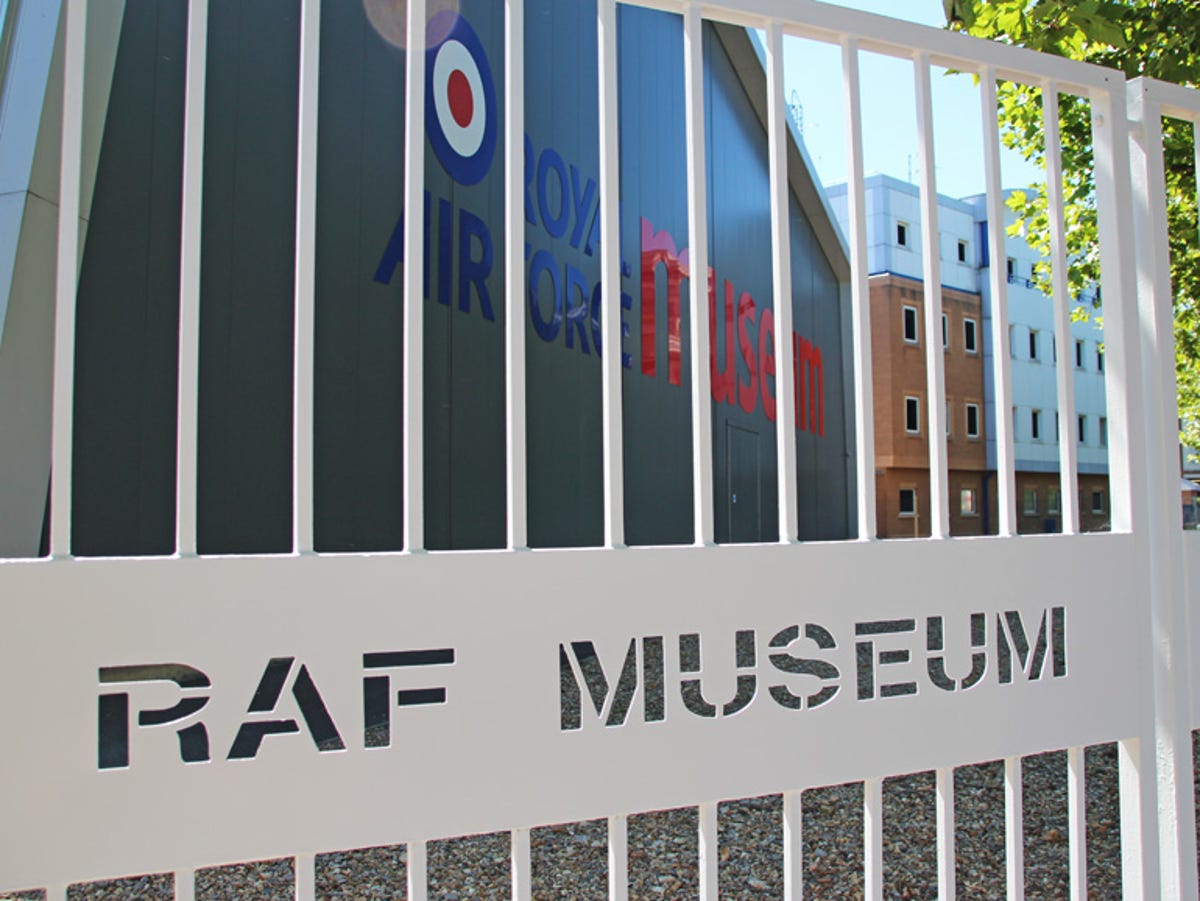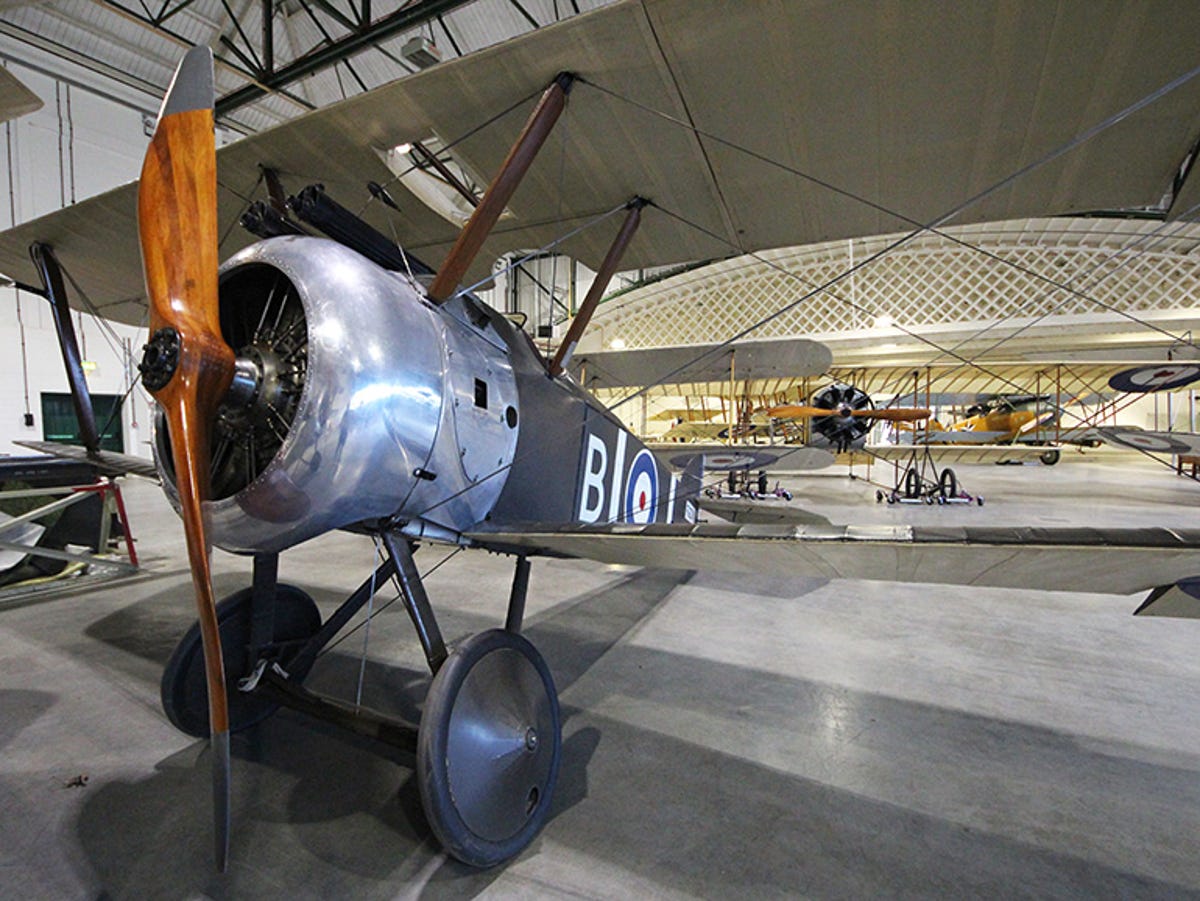A tour of the Royal Air Force Museum (pictures)
The Royal Air Force Museum London houses over 100 aircraft from the past 100 years. From delicate WWI planes, to iconic WWII fighters and bombers, to jet aircraft from the '40s and to the present day. Here's a huge photo tour.

Colindale
Opened in 1972, the RAF Museum fills five hangars with warplanes from the past 100 years: restored WWI fighters, seaplanes, WWII fighters and bombers, and jet aircraft from the Cold War's earliest days, to the Harrier and the F-35.
I've been to a lot of air museums, but the RAF Museum had many planes I'd never seen before, and many that are the only ones in existence. If you're in London, definitely head up to Hendon, especially since you can't beat the entrance price: free.
Unless you drive there, you enter the grounds after a short walk from the Colindale station on the Northern Line. It's about a 15 minute walk.
For the full story behind the tour, check out A tour of the Royal Air Force Museum.
Milestones of Flight Hall
There's quite a mix of aircraft in the Milestones of Flight Hall. Up close, here, you can see the Eurofighter Typhoon; off to the left is a P-51D Mustang.
Mossie
One of my favorite WWII planes, the de Havilland Mosquito.
Lightning II
A mock-up of the new F-35 Lightning II.
First Allied Jet
Here's a wonderfully well-preserved Gloster Meteor, the first operational allied jet. The visual difference between it and the Mosquito adjacent is extreme, especially considering they're from the same era.
Jump jet
I was surprised at how small the Harrier is in person. A big station wagon wouldn't be much smaller, really. This one's all engine (you can see the top of the engine at the bottom of the frame).
Power
The legendary Rolls-Royce Merlin engine, used in...well, practically everything on the Allied side in WWII.
Me(an)
It's a mean looking aircraft, and could almost pass for a modern-day jet. Hard to imagine this was flying at the same time as Spitfires and Hurricanes.
The Bomber Hall
The sprawling Bomber Hall (though, I guess it'd have to be), features some iconic and rarely seen aircraft. This display features a Handley Page Halifax salvaged from a lake in Norway after a belly landing.
Liberator
The B-24 Liberator. Though not as famous as the B-17, it was faster, carried more, and had a longer range.
The Icon
The famed B-17. Probably the most recognizeable bomber in history.
Which one?
Which model B-17 is it? Easy to tell with this photo...
Shrike
This Fw 190 was modified with a second seat after production, but not much else is known about its history.
All wing
The Avro Vulcan is so massive, it's hard to get it all in one photo. Here you can see some of its bomb load, under its massive delta wing.
Like night
The huge wing does a great job shadowing the walkway.
B-17 and Bf109G
While the planes are rightfully the stars of the show, the other objects, like engines and cars, add to the character.
It's also interesting to see these two nemeses side by side, especially noting how small the Bf109 really is.
Royal Aircraft Factory F.E.2b
Pretty big for a WWI plane, the Royal Aircraft Factory F.E.2b was a fighter, bomber, and anti-submarine aircraft.
Exposed
Not much protection from the elements, or anything else, plus it was powered by an engine that probably has less power than the one in your car.
Lancaster
In the center of the bomber hangar is the impressively massive Avro Lancaster. I've seen B-17s and B-24s up close (even before this tour), but neither are as huge as the Lancaster.
Merlins
Just imagine one of these huge beasts rumbling down the runway or soaring overhead.
They were powered by Merlins as well.
S-Sugar
This Lancaster flew 137 sorties.
Big bombs
Because of its cavernous bomb bay, the Lancaster carried the huge "blockbuster" bombs of the day.
It's a boat!
Along with bombers, I adore seaplanes. Probably from watching too much "TaleSpin" as a kid.
This is a Supermarine Stranraer.
Sopwith 7F.1 Snipe
The Snipe was intended as a replacement for Sopwith's excellent Camel (which we'll see later).
Airco DH.9A
The DH.9A was a WWI bomber, but only came into service toward the end of the war.
Standing close to them, it's interesting how little size difference there is between most WWI bombers and the fighters (compared with later versions of the same types of aircraft, anyway).
Note the wooden wheels.
F4
It's not just all propeller craft at the RAF Museum; there are quite a lot of modern jet aircraft, like this F4 Phantom.
Cockpit
The cockpit for the F4. Sadly, you couldn't get in this one (there's a small jet trainer you can sit in, though).
Part of one hangar
Here you can get a sense of the overall size of the place: this is roughly one quarter of the Historic Hall. The Bomber Hall is a little smaller, but not much.
Thunderbolt
The beefy Republic P-47 Thunderbolt. It was equipped with eight .50 caliber machine guns, plus this model could carry 2,000 pounds of bombs. Fierce, and the predecessor (namesake-wise, anyway) of the epic A-10.
Seems to be missing something...
While I'd love to take a flight in a WWI airplane, I can't say I'd be at ease. Not sure why...
Engine experimentation
The early years of flight saw some fascinating experiments with planes, engines and everything.
This is a Napier Dagger, which has an "H" cylinder configuration (as opposed to the more familiar "V" or in-line designs).
Grrrr
Did every P-40 have teeth painted on?
Aww, so cute.
Can I have one? It's adorable: a tiny jet trainer called the BAC Jet Provost.
Lightning
The BAC Lightning F.6, with its unusual over-wing fuel tanks.
OK, I get it
Either this was a coincedence, or someone amused themselves with this sign placement.
Pronounced "Canbra"
The English Electric Canberra PR.3. While built as a (very) high-altitude light bomber, it also worked well as a surveillance aircraft for the same reason.
The American version was called the B-57.
de Havilland Vampire
The Vampire entered service just after WWII, and certainly looked a lot weirder than its (rather staid-looking) contemporary, the Meteor.
Two into one
Despite the two intakes, the Vampire was powered by a single turbojet.
Booms
Though not related, there is some resemblance to the P-38, right?
Battle of Britain Hall
The Battle of Britain Hall shows what life was like in Britain during the Blitz.
Daffy
The Boulton Paul Defiant was a two-seat interceptor where the pilot had no weapons, relying on a gunner with a turret. Not awesome against fighters, but it did do well against bombers.
Bf 110
This is the only intact Bf 110 in existence. Most effective as a long-range and night fighter, it also was used as a fighter-bomber.
88
This Junkers Ju 88 was given to the British by its pilot, who defected and landed at what is now Aberdeen International Airport. The co-pilot was also in on the defection, but the radio operator was not.
It was all orchestrated by the Secret Service.
Light bomber
The He 111 was already pretty old when WWII started, but continued to be used until the end of the war.
Legend I
The legendary Hawker Hurricane. The RAF Museum's description: "Hurricanes destroyed more enemy aircraft during the Battle of Britain than did all the other air and ground defenses combined."
Legend II
And the Hurricane's legendary (and more famous) counterpart, the Supermarine Spitfire.
Powered by...
What's inside? Oh yeah, that Merlin again...
Stuka
Hard to miss the inverted gull wings of the Ju 87.
Dive bomber
That iconic wail of a dive bomber on attack? Made from a siren attached to the landing gear.
V-1
Basically the WWII version of the cruise missile, the V-1 used a pulsejet engine.
I call him Bubba.
The Short Sunderland seaplane. The name "Flying Boat" has never seemed more apt. Note how an engineer can crawl through the huge wing and work on the engine (not in flight, presumably).
Up front
Inside the Short Sunderland. Sorry about the mediocre picture, but with the lights facing scratched plastic...
This is the forward gunner position. He could winch the gun turret out of the way to secure lines after landing.
Loo
With missions lasting many hours, it's not like you can pull over for a pit stop.
Bunks
Some missions had multiple crews so some could rest while the others were on duty.
Mess
There's even a small galley, with a propane stove.
Bomb bay
During normal flight, the hatches would be closed, and those bomb racks would be inside the boat. Plane. Boatplane.
Tailgunner
Here a tailgunner works his way forward out of the long tail of the Sunderland.
Stubby
The wings were much wider than the Sunderland was long.
V-2
Where the V-1 was a cruise missile, the V-2 was the first ballistic missile.
Duck
The business end of the V-2.
The Grahame-White Factory
The WWI hangar is called the Grahame-White Factory (its own interesting story). When I was there it was in the process of being redone for the 100th Anniversary of the Great War.
The fuselage in the foreground is a Sopwith 1 1/2 Strutter.
3 and 2
These aircraft are now at the other RAF Museum, at Cosford. The foreground is a Sopwith Triplane, the other the legendary Sopwith Camel.
Three must be better than two (or one)
This is one of two remaining Sopwith Triplanes, and it was restored to flying condition.

Camel
Certainly one of the most famous WWI aircraft, up there with the Fokker Triplane (though the Camel was aguably the better plane)
Where's the middle?
The rather bizarre, but still rather cool-looking, French Caudron G3.
Sesquiplane
This design is called "sesquiplane," meaning one of the wing pairs is smaller than the other.
Struts
All the aircraft are beautifully maintained, looking like they just rolled out of the factory.
Albatros DVa
The quite gorgeous Albatros DVa, with its in-line liquid-cooled engine (hence the smooth shape).
Lines
Though sleek in lines, the DVa didn't perform as well as its British adversaries.
Royal Aircraft Factory S.E.5a
The boxy (but fast) Royal Aircraft Factory S.E.5a.
Avro 504k
The Avro 504k (the skid was stock), which was used early in the war, but was soon replaced by better performing airplanes.
Into the wild blue...
The RAF Museum was one of the best air museums I've ever been to, and well worth a trip out of London for any airplane buff. And it's free!
For the full story behind the tour, check out A tour of the Royal Air Force Museum.

